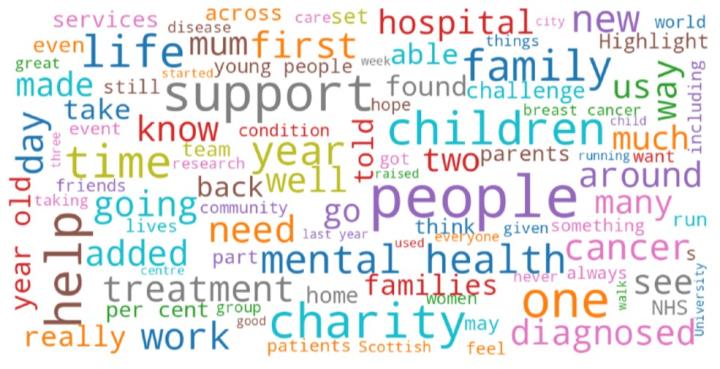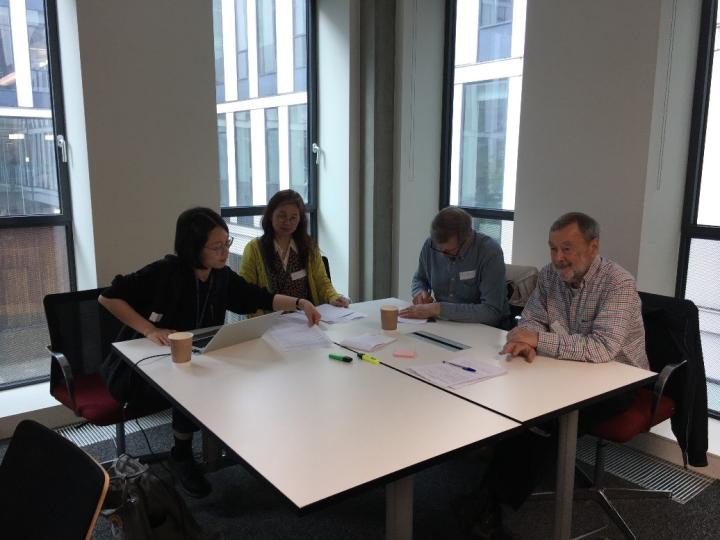How can newspaper articles and neighbourhood characteristics explain population health in Edinburgh?
Read about a recent project looking at the relationship between news items and population health.
What was the aim of the project?
Neighbourhood properties greatly influence population health; however, factors like social support or antisocial behaviour, are not easily measured by official methods. To help us better understand the different characteristics of local areas, our research team used a new approach to find words that frequently occur in newspaper articles reporting on different neighbourhoods in Edinburgh. These words were put into word clouds, such as the one below. However, as many of the research team are relatively new to Edinburgh, deducing the topics, neighbourhood characteristics, and potential effects on the health of local populations was tricky.

To help with this, we were keen to discuss the word clouds with long-term residents of Edinburgh to understand what topics they felt the word clouds represented. In so doing, public members would also provide insights as to why the topics were the focus of newspaper articles. We hoped that this would deepen our understanding of novel neighbourhood risk factors of population health in Edinburgh and potentially other cities too.
What did the PPI look like?
Prior to the PPIE event, attendees were sent word clouds that contained the most commonly occurring words associated with population health in Edinburgh neighbourhoods. Attendees annotated the word clouds with potential themes before seven Edinburgh residents joined us for an in-person workshop. During the workshop, attendees discussed what theme or topic, such as ‘cycling’ or ‘crime’, best represented each word cloud. They then explored possible ways that the agreed themes could impact population health and under what circumstances.
What training and support was offered to public contributors?
Public contributors received information about the research and help was provided as needed to support the annotation of the word clouds before the workshop. This meant that attendees were familiar with the research and word clouds prior to attending the event. Statements were provided to stimulate table discussions and members of the research team acted as facilitators on each table to aid conversation.
What was the impact of involving public contributors?
Using their local knowledge, the public contributors attending our workshop provided us with invaluable insights into how the risk factors identified in the word clouds may impact health. Being familiar with the localities in Edinburgh meant that they could share new perspectives that we might not have imagined because we are newcomers to the study area. In this way, the contributions of the attendees are informing our ongoing research and we hope that, when our findings are published, public members will feed into relevant public policies. On top of this, the contributors’ ideas are shaping further aspects of our ongoing statistical data analysis.
What were the challenges?
Recruiting workshop attendees was not straightforward as we were looking for long-term residents of Edinburgh who could attend an in-person workshop and who read local newspapers. To address this, we distributed flyers across Edinburgh and shared our workshop with local community organisations. We did have a few people drop out at short notice, so in future we would hope to over-recruit to allow for this.
Advice for researchers considering PPI.
- Make room for potential last-minute changes to attendee availability and make a contingency plan, such as changing the number of discussion groups, to mitigate the effects of any non-appearances.
- Try and recruit a diverse range of public members. For instance, our main discussion was neighbourhood disadvantage; therefore, having more contributors experiencing or well-aware of the neighbourhood deprivation would have been beneficial. However, recruiting such people was a challenge throughout the planning phase.
- Consider sharing all the questions that you plan to cover during the discussion with attendees in advance of your event. This gives people a greater insight into what will be covered on the day and can provide a more fruitful discussion.


